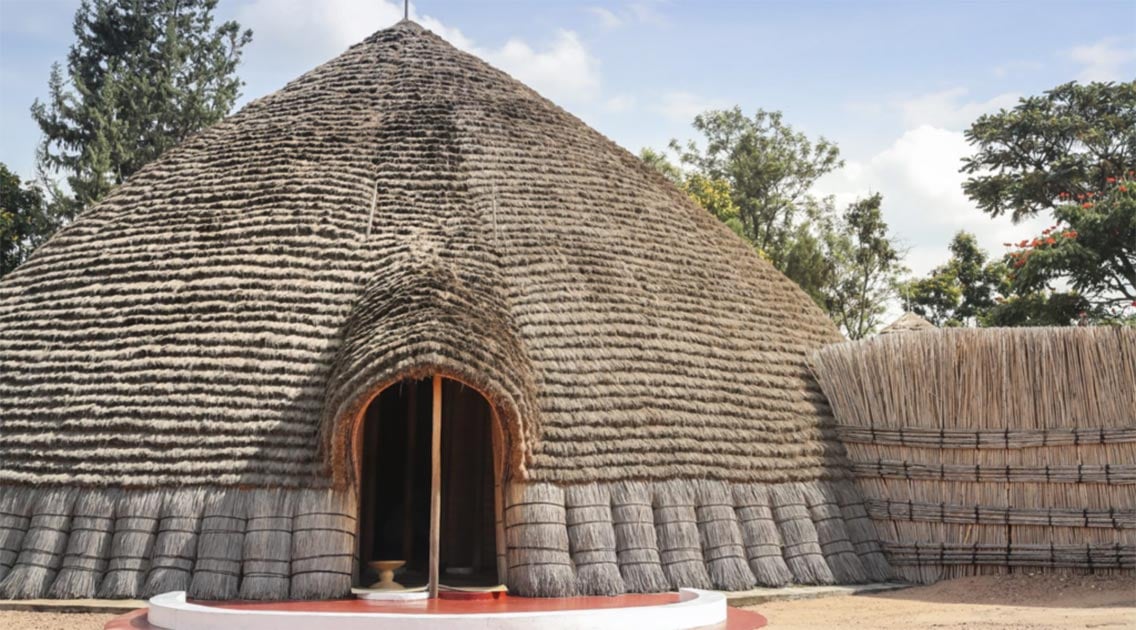The Contrasting Royal Palaces of Rwanda
Rwanda, known as the land of a thousand hills, is one of the best countries to spot gorillas in their natural habitat. It is emerging from a bloody past and is now one of the most dynamic societies in Africa. Nyanza Royal Palace, one of the most important historic sites in the country, is a replica of the large traditional structure that was home to Rwanda’s monarchy until its abolition in 1962. Adjacent to it stands a more recent palace that was built for the monarch in 1932. Today the modern palace is also a museum and a heritage park.
History of Nyanza Royal Palace
The Nyanza Royal Palace is intertwined with the modern history of the Rwandan monarchy, which was established in the wake of the collapse of the Bachwezi Empire in the 1500s.
The Rwandan kings were Tutsis and ruled over a majority Hutu population. The Hutus, however, played a significant role in the government and in many ways the two groups were integrated to such an extent that they are often seen as one people.

Yuhi Masinga, king of Rwanda from 1896 to 1931 (Photo by therwandan)
The Rwandan kingdom came under the control of the Germans by 1890. After Germany’s defeat in WWI they were forced to transfer the area to the control of Belgium. The Germans, and later the Belgians, used the Rwandan monarchy to rule the country.
Yuhi V of Rwanda, who refused to cooperate with the Belgians and convert to Catholicism, was forced to abdicate by the colonists. He inhabited the original palace, which had been built in the 19 th century.
Even under the colonial administrations of Germany and Belgium, the Nyanza Royal Palace held important ceremonial and ritual significance for many people, and Rwandan kings continued to hold court there.
Mutara III Rudahigwa came to power in 1931 and the palace is often named after him. He was the first Rwandan monarch to convert to Catholicism and this led to a wave of conversion in the country. His reign was also marked by rising tensions between Hutus and Tutsi.

Mutara III Rudahigwa, who ruled Rwanda from 1931 to 1959 (Twitter)
In 1932 a modern palace was built for the new Rwandan monarch. In 1962 after a referendum, not long after Rwandan independence, the monarchy was abolished. The old and the new palace were abandoned and fell into a state of disrepair.
By the 2000s the original palace was almost totally gone because it was made of perishable materials. The Rwandan government sponsored a project to restore the old and the modern palace and local skilled craftspeople were used to recreate the original buildings.
The Sights of Nyanza Royal Palace
A replica was built of the palace first built on the site in the 19 th century. This round building, or wheelhouse, was once very common in this part of central Africa and all the houses in Rwanda were built on a similar design, but on a smaller scale.
Nyanza Palace’s clay walls are decorated with geometric patterns and the palace is surrounded by an enclosure. The expansive canonical woven thatch roof is supported by a series of poles. In the former royal residence, a few artifacts that belonged to the royal family of Rwanda remain. The reconstructed palace offers a unique insight into the pre-colonial past of Rwanda.
- Looking for Clues on the Hill of the Jackal: The Rich African Kingdom of Mapungubwe
- Shaka Zulu: The Story of a Ruthless Ruler
- Ten of Africa’s Most Powerful Kings, Queens, Warriors and Legends

The tall poles supporting the beautiful woven roof (Photo by Momaa)
The new royal palace, built in 1932, was made of concrete and has a long veranda. Despite being inspired by European models, its central courtyard still reflects traditional Rwandan layouts. This new palace is officially a museum, but the palace’s contents and valuables were looted, and only photographs remain. Royal tombs were set in the gardens that surround the modern palace.
The elegant Inyambo cattle played an important role during royal ceremonies in honor of the king. They were decorated with jewelry and were taught to follow the commands of their trainers in parades. The Rwanda Agriculture Board still oversee the breeding of these cattle.

The traditional Inyambo cattle of Rwanda (Visit Rwanda)
Visiting the Nyanza Royal Palace in Rwanda
The palace is near the town of Nyanza, which is some 2 and a half-hour drive from the capital of Rwanda, Kigali. An entrance fee of 7 dollars is charged to visit the palaces. A guide is provided with the entrance fee and there are many information boards available that provides an overview of the history of the location.
Top image: Nyanza Royal Palace, Rwanda Source: Photo by Momaa
By Ed Whelan
References
Adekunle, J. (2007). Culture and customs of Rwanda. Greenwood Publishing Group
Loca, L. L., & Loc, L. L. (2011). Conservation in Rwanda. Context, 120, 23
Guddal, S. (2010). Archaeology and the Construction of Identities in Past and Present Rwanda (Master's thesis, The University of Bergen)
Available at: http://dspace.uib.no/handle/1956/4137


















Comments
It looks like an igloo. Was half expecting to see a Rwandan Pingu the penguin come out and start skating around.